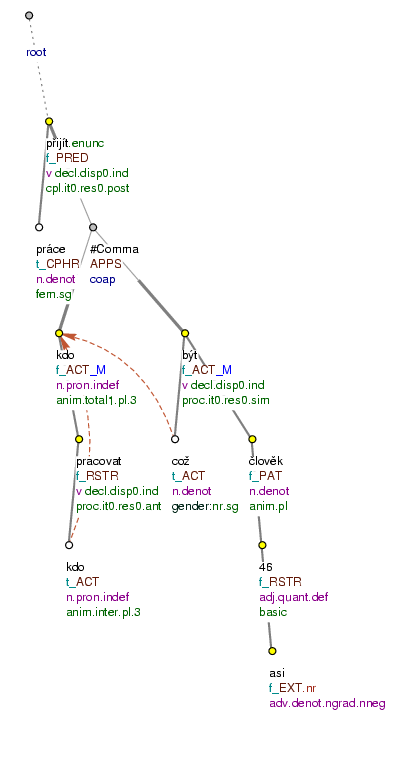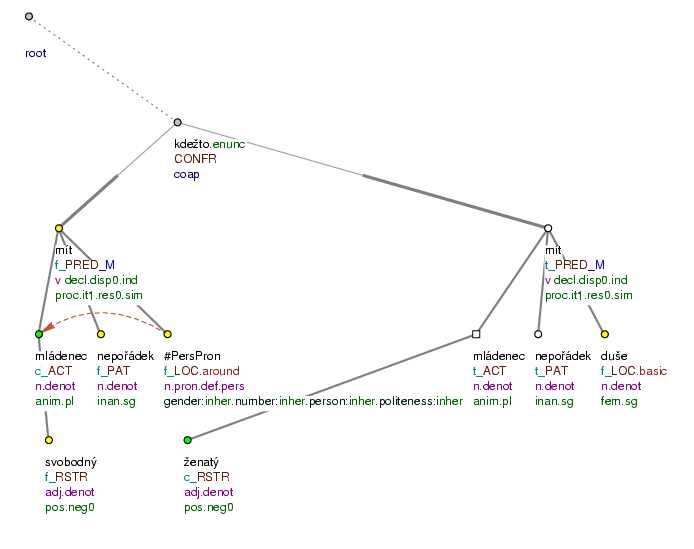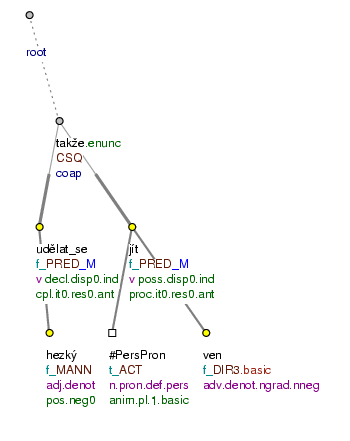Constructions with false dependent clauses are such connections of two clauses in which there is a semantic relation of coordination but in which, formally, one clause depends on the other.
By using a subordinating conjunction, a new meaning (aim, condition) is introduced into the clausal connection, which is not in fact present between the propositions. The decision of the author to use this form is respected in the annotation (i.e. the meaning/content is subordinated to the form here). The use of such a form has a certain stylistic effect.
The effective root node of a false dependent clause has a functor according to the used connective and depends on the effective root node of the governing clause.
If the connective is a conjunction which is gradually becoming a coordinating conjunction, the whole clausal connection is taken to be a paratactic connection. We mention these cases here since they are often considered to be cases of subordinate clauses, the connectives being subordinating conjunctions.
False dependent clauses are either relative (see Section 5.4.1, "False relative clauses") or conjunctional (see Section 5.4.2, "False dependent conjunctional clauses") clauses.
False (dependent) relative clauses, introduced by relative pronouns or adverbs (který (=which), kde (=where)), are analyzed as dependent clauses whose effective root nodes depend on a noun and are assigned the RSTR functor.
Examples:
Spadl pod vlak, který ho přejel.RSTR (=He fell under a train, which ran him over) Fig. 6.67
Obvinili ředitelku za špatné zacházení se psy, kteří v útulku údajně hynou.RSTR hladem. (=... bad treatment of the dogs, which are dying)
Figure 6.67. False relative clauses
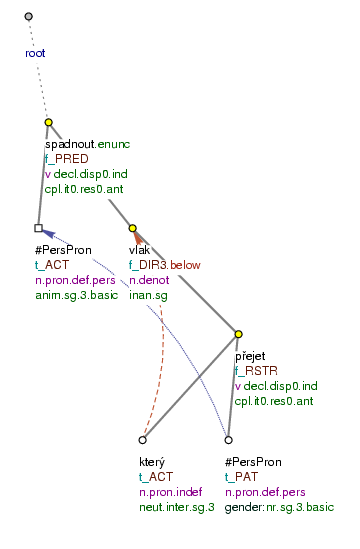
Spadl pod vlak, který ho přejel. (=lit. (He) fell under train, which him ran_over)
Those clausal connections in which the second clause is introduced by the connectives: což, přičemž, načež, pročež, začež, aniž etc. (sometimes considered to be cases of false dependent clauses), are usually taken to be paratactic connections in PDT.
For the annotation rules regarding paratactic structures, see Section 6, "Parataxis".
The connectives což, přičemž, načež, pročež, začež, aniž etc. are divided into two groups depending on whether the connective is a modification of the dependent clause or not:
-
connectives that are not modifications themselves and are turning into coordinating conjunctions:
přičemž načež začež pročež aniž The nodes representing these connectives are paratactic structure root nodes. The semantic relation between the clauses is expressed by one of the functors used for paratactic connections (see Section 12, "Functors expressing the relations between the members of paratactic structures").
Examples:
Nedohodli se, pročež.
CSQnastal nový boj. [nodetype=coap] (=They didn't reach an agreement, which was the reason to start a new fight) Fig. 6.68Vyšel z domu, načež.
CONJzačala bouřka. [nodetype=coap] (=He came out of the house and the storm began immediately)Šel, přičemž.
CONJneviděl. [nodetype=coap] (=He was walking without seeing/and didn't see)The connective "aniž". The connective aniž (=apprx. and_not) negates the predicate in the second clause. Therefore, a new node representing the syntactic negation is inserted into the structure (with the
#Negt-lemma) - it depends on the effective root node of the paratactic structure and is assigned theCMfunctor (see also Section 16.1.2, "Conjunction modifiers"). Cf.:-
Dostal odměnu, aniž.
ADVSse o ni zasloužil. [nodetype=coap] (=He got a reward without deserving it)= He got a reward but he didn't deserve it.
There is a newly established node for syntactic negation dependent on aniž in the tree, with the
#Negt-lemma and theCMfunctor (cf. Fig. 6.69).
-
-
connective which is a modification at the same time:
což The connective což (also in the forms: bez čehož (=without which), čemuž (=to_which), za což (=for which)) is often a modification in the clause it introduces. The node representing což has a functor, then, according to its position in the clause. The root node of the paratactic structure is the node representing the comma. The effective root nodes of both clauses are assigned the same functor.
Examples:
Při reklamaci došlo k chybě, za což.
PATse vám omlouváme. [#Comma.CONJ] ( =There was an error in processing the complaint, for which we apologize) Fig. 6.70Dostal jich jen 5, což.
ACTje ostuda. [#Comma.CONJ] (=He only got five, which is a shame) Fig. 6.71NB! Clauses introduced by což do not have to refer to the whole preceding clause but can also refer just to a part of it. In such cases, there is a paratactic connection between the second clause and the part (of the first clause) it relates to. Often, the relation is that of apposition. Also here, the effective root nodes of both clauses are assigned the same functor.
Examples:
O práci přijdou všichni.
ACT[is_member=1] , kdo pracovali, což.ACTje.ACT[is_member=1] asi 46 lidí. [#Comma.APPS] (=All employees will lose their jobs, which is about 46 people) Fig. 6.72Doufám, že problémy se budou projednávat s kvalifikovanými lidmi.
ADDR[is_member=1] , což.ACTjsou.ADDR[is_member=1] především funkcionáři federálních svazů. [#Comma.APPS] (=I hope the problems will be discussed with competent people, which are especially ...)
For the grammatical coreference with což see Section 2.2.2, "Coreference of the relative element "což"".
Figure 6.68. Constructions with "pročež"
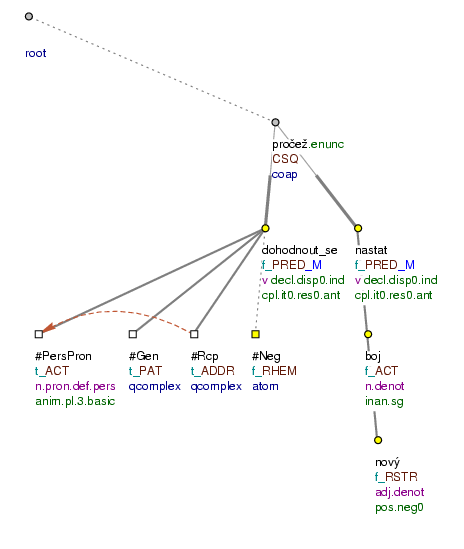
Nedohodli se, pročež nastal nový boj. (=lit. (They) not_reached_agreement REFL, for_which_reason started new fight)
Figure 6.69. Constructions with "aniž"

Dostal odměnu, aniž se o ni zasloužil. (=lit. (He) got reward and_not REFL about it deserved)
Figure 6.70. Constructions with "což"
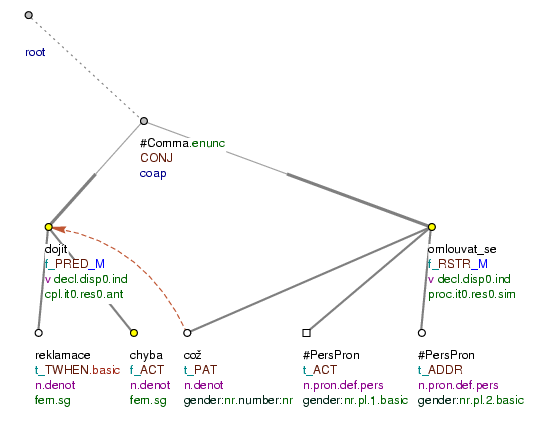
Při reklamaci došlo k chybě, za což se vám omlouváme. (=lit. With complaint happened to error for which REFL (we) you apologize)
False dependent conjunctional clauses are especially false purpose clauses introduced by the conjunction aby and false dependent conditional clauses introduced by jestliže, -li or když.
False purpose clauses. False purpose clauses with the conjunction aby are analyzed as dependent clauses and their effective root nodes are assigned the AIM functor.
Example:
Odešel, <aby> se už nevrátil.AIM (=He left to never come again) Fig. 6.73
False conditional clauses. If the conjunctions jestliže, -li or když are used to express confrontation, the choice of the form is respected and the construction is analyzed as containing a dependent conditional clause (its effective root node is assigned the COND functor).
Example:
<Jestliže> Sparta v první třetině vyhrávala.COND , nakonec prohrála. (=While (lit. if) Sparta was winning in the first third, they lost in the end) Fig. 6.74
Figure 6.73. Constructions with false purpose clause
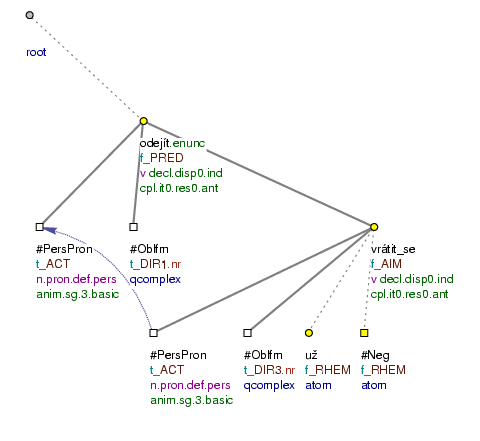
Odešel, aby se už nevrátil. (=lit. (He) left so_that REFL (he) already would_not_return)
Figure 6.74. Constructions with false conditional clause
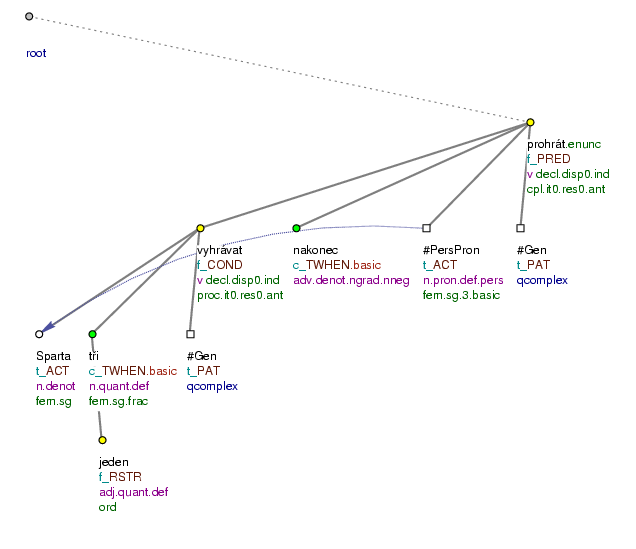
Jestliže Sparta v první třetině vyhrávala, nakonec prohrála. (=lit. If Sparta in first third was_winning, finally (they) lost)
The conjunctions kdežto and takže (sometimes considered to be subordinating conjunctions) are analyzed as coordinating conjunctions in PDT and the clauses they connect as coordination.
The connective "kdežto". The node representing kdežto is a paratactic structure root node and is assigned the CONFR functor (see also Section 12.1.2, "CONFR").
Example:
Svobodní mládenci mívají nepořádek kolem sebe, kdežto.CONFR ženatí mívají nepořádek v duši. [nodetype=coap] (=Bachelors often have a mess all around them whereas married men have a mess in their souls) Fig. 6.75
The connective "takže". The node representing takže is a paratactic structure root node and is assigned the functor CSQ (see also Section 12.1.5, "CSQ").
Example:
Udělalo se hezky, takže.CSQ jsme mohli jít ven. [nodetype=coap] (=The weather got really nice so we were able go out) Fig. 6.76
The conjunction zatímco is analyzed as a subordinating conjunction that introduces clauses with the functor TPAR (see Section 3.7, "TPAR") or CONTRD (see Section 9.2, "CONTRD"). If this conjunction is used to express confrontation, the clause it introduces is not interpreted as a false dependent clause (like with the conjunction jestliže (=if)), but rather this meaning is taken to be one of the regular meanings of the conjunction and it is expressed by a special functor: CONTRD.
Example:
<Zatímco> dole ve vrátnici bylo.CONTRD dusno, tady nahoře je.PRED ovzduší doslova nedýchatelné. (=While at the reception, the air was stuffy, here, upstairs, it is utterly impossible to breathe)

